![]()
![]()
![]()
Use LEFT and RIGHT arrow keys to navigate between flashcards;
Use UP and DOWN arrow keys to flip the card;
H to show hint;
A reads text to speech;
80 Cards in this Set
- Front
- Back
|
Facts about the human Heart: |
- The human heart is a strong muscular pump about three quarters the size of a clinched fist.
- It weighs less than 1 pound (approximately 250-350 grams).
- It lies in the thoracic cavity in the mediastinal space (a mass of tissues and organs lying behind the sternum, between the lungs, and in front of the vertebral column).
- The heart is shaped like an irregular and slightly flattened cone. |
|
|
APEX |
Lower point of the heart, formed by the tip of the left ventricle. (the apical pulse is counted here) |
|
|
What are the 3 layers of the heart wall? |
- endocardium
- myocardium
- epicardium
|
|
|
ENDOCARDIUM |
(Inner heart) is a membrane lining the hearts interior wall. |
|
|
MYOCARDIUM |
middle and thickest layer of the heart wall; the muscular layer. |
|
|
EPICARDIUM |
The thin, outer layer of the cardiac wall. |
|
|
PERICARDIUM |
A sac that surrounds and protects the heart. |
|
|
What are the 3 layers of the pericardium? |
- epicardium
- parietal layer
- fibrous pericardium
|
|
|
EPICARDIUM |
Portion of the heart wall, which also makes up the pericardium's visceral layer, adheres to the heart's surface. |
|
|
PARIETAL LAYER |
The inner serous pericardium. |
|
|
PERICARDIAL SPACE OR CAVITY |
The space between the visceral and parietal layers. |
|
|
The Heart |
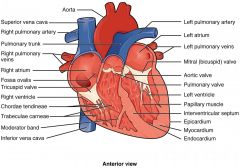
|
|
|
PERICARDIAL FLUID |
Acts as an lubricant and reduces friction between the layers ad the heart contracts and relaxes. |
|
|
FIBROUS PERICARDIUM |
The outermost layer; composed of dense fibrous connective tissue. |
|
|
SEPTUM |
A complete muscular wall that divides the heart into right and left sides. |
|
|
What are the 4 chambers of the heart? |
- right atria (atrium) - left atria (atrium) - right ventricle - left ventricle |
|
|
Right and Left atria (atrium) |
the two upper chambers; thin walled, low-pressure chambers are the receiving centers for blood. |
|
|
Right and Left ventricle |
the two lower chambers; are high pressure chambers; they pump blood out of the heart.
The left ventricle must contract with sufficient force to send blood to the entire body; therefore its muscle walls are the thickest and its internal pressures the highest.
The right ventricle needs only to pump blood into the low pressure lungs and therefore is a thinner-walled chamber. |
|
|
KEY CONCEPT |
The left ventricle contains the thickest layer of muscle in the heart. It must pump strongly enough to send blood out to the entire body. The right ventricle also has thick muscles; the muscles in the atria are thinner than those of either ventricle.
The left lung is smaller than the right lung, to make room for the heart. |
|
|
VALVES |
As each heart chamber contracts, it pushes blood either into a ventricle or out of the heart to the lungs or body. The cardiac valves are one-way flaps of tissue that open and close in response to pressure changes within the chambers. These unidirectional (one-way) valves allow blood to flow in one direction only, preventing backflow.
|
|
|
Atrioventricular (AV) Valves |
valves that lie between the atria and ventricles. |
|
|
Tricuspid Valve |
valve between the right atrium and the right ventricle. |
|
|
Mitral Valve (bicuspid valve) |
valve between the left atrium and the left ventricle. |
|
|
chordae tendineae |
tendon like strands that are anchored to papillary muscles located on the inner surface of the ventricles. |
|
|
SEMILUNAR VALVES |
Each ventricle empties through a valve with 3 cresent shaped (half-moon) cusps called the SEMILUNAR VALVE. |
|
|
Pulmonary semilunar valve |
separates the right ventricle from the pulmonary artery (also called the pulmonic valve). |
|
|
Aortic (semilunar) valve |
separates the left ventricle from the aorta, the body's largest artery. |
|
|
KEY CONCEPT |
The pulmonary arteries are the only arteries in the body that carry deoxygenated blood. The pulmonary veins are the only veins that carry oxygenated blood. The oxygen saturation of the hemoglobin within the arteries is normally about 95%-100%. Within the veins, it is about %75%. |
|
|
Blood flow through the heart: |
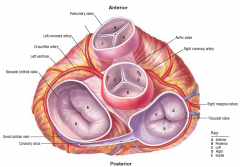
|
|
|
Blood flow through the heart: |
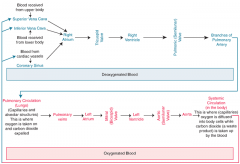
|
|
|
Coronary arteries and cardiac veins: |
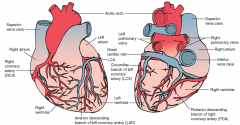
|
|
|
Left coronary artery (LCA) also known as Left main coronary artery (LMCA): |
Passes along the left atrium and divides into two branches: the left anterior descending (LAD) artery and the left circumflex (LCX) artery |
|
|
Left anterior descending (LAD) artery: |
descends along the anterior intraventricular groove to provide blood to most of the ventricular septum and anterior portion of the left ventricle. The LAD and its branches also supply blood to the anterior papillary muscles, the apex of the left ventricle and the right and left bundle branches. |
|
|
Left circumflex (LCX) artery: |
Extends around the left side of the heart, along the groove between the left atrium and left ventricle, to supply blood to the left atrium and the lateral and posterior portions of the left ventricle. It supplies blood to the sinoatrial (SA) node in approximately 40% of the population and the AV node in approximately 10% of the population. |
|
|
Right coronary artery (RCA): |
Branches out along the right AV groove to supply blood to the right atrium and right ventricle. It provides blood to the SA node in approximately 60% of the population and to the AV node in 90% of the population. |
|
|
Marginal Branch |
the main branch of the RCA that supplies the hearts right side. |
|
|
Ischemia |
Reversible cell injury due to decreased blood and oxygen supply. |
|
|
Myocardial Infarction (MI) |
A localized area of dead tissue caused by a lack of blood supply (heart attack). |
|
|
Collateral circulation |
Circulation that occurs when one blood vessel is plugged and another evolves to take over it's function, usually in the heart. |
|
|
Coronary Sinus |
returns blood to the right atrium |
|
|
Key Concept |
Arteries carry blood away from the heart. Veins carry blood toward the heart. Except in the pulmonary circuit, arteries carry oxygenated blood and veins carry deoxygenated blood. |
|
|
AORTA |
The largest artery in the body. |
|
|
PRINCIPAL SYSTEMIC ARTERIES: |
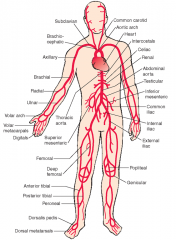
|
|
|
Microcirculation |
Blood flow through capillaries |
|
|
Key Concept |
The capillaries are very important. They are known as "exchange vessels" because it is here that the exchange of nutrients and wastes occurs. |
|
|
Superior vena cava (SVC) |
Returns blood from the head, neck and arms. |
|
|
Inferior vena cava (IVC) |
Returns blood from the lower body. |
|
|
KEY CONCEPT |
When a vein is cut, the muscles in the wall constrict, and blood flows in a steady stream rather than pulsating like arterial blood. |
|
|
Key Concept |
If placed end-to-end, the blood vessels in an average human body would measure about 100,000 km-twice around the earth.
Some blood vessels are modified to serve specific functions.
Examples include the sinusoids of the liver and spleen, and the choroid plexes within the ventricles of the brain. |
|
|
vasoconstriction |
contraction of veins. |
|
|
The layers within arteries and veins are? |
-Tunica adventitia- the outermost layer. This layer is composed of connective tissues and nerve cells, as well as nutrient capillaries in larger vessels. This layer protects the outside of the vessel.
-Tunica media- the middle layer. This layer contains the thickest elastic fibers, as well as connective tissue composed of polysaccharides. This layer is covered by a thick elastic band (the external elastic lamina) and smooth muscle fibers, which control the caliber (size) of the vessel.
-Tunica intima - the innermost layer. This layer is the thinnest-a single layer of simple squamous endothelium held together by an intercellular matrix. This layer is surrounded by connective tissue interlaced with elastic bands (internal elastic lamina). |
|
|
Key Concept |
The blood vessels do not pump blood, they can regulate their diameter (especially the arteries). This helps to change blood flow to specific organs, regulate blood pressure and regulate body temperature. (thermoregulation) |
|
|
SA node (sinus node) |
Is embedded in the wall of the right atrium where it is joined by the superior vena cava (SVC). It is also considered the heart's "pacemaker" |
|
|
Key Concept |
A syncytium is a merging of cells interconnected by cytoplasmic bundles. This meshwork allows an electrical stimulus in one cell to spread through the network to the other cells. The person with a poorly functioning SA node usually requires the implant of an electronic pacemaker. |
|
|
Special bundles of unique tissue in the heart transmit and coordinate electrical impulses to stimulate the heart to beat are called: |
- SA node or sinus node
- AV node
- Bundle of His
- Right and left Bundle Branches
- Purkinje Fibers |
|
|
Atrioventricular node (AV node) |
found in the lower part of the right atrium near the ventricle. |
|
|
Key Concept |
The electrical activity of the heart must occur before the mechanical, or pumping, activity of the heart can respond with a heartbeat. |
|
|
Key Concept |
Conduction System of the Heart
- SA (sinoatrial) node (pacemaker)
- AV (atrioventricular) node
- Bundle of His (AV bundle)
- Right and left bundle branches
- Purkinje fibers to muscles of ventricles.
|
|
|
Key Concept |
In less than 1 second, both atria contract as both ventricles relax. Immediately after this, both ventricles contract as both atria relax. This process is considered on cardiac cycle or one heartbeat. |
|
|
SYSTOLE |
The sequence of dual contractions, the atria followed by the ventricles.
Systole makes up one-third of the cardiac cycle. |
|
|
DIASTOLE |
Atrial relaxation. followed by ventricular relaxation.
Diastole takes up two thirds of the cardiac cycle.
|
|
|
Key Concept |
The contraction that pumps the blood from the heart is called systole, and the period when the heart relaxes is called diastole. The heart is actually in systole twice, once for the atria (atria systole) and once for the ventricles (ventricular systole). |
|
|
S1 |
The first normal heart sound is called the "lub" and is produced by closure of the AV valves when the ventricles contract. |
|
|
S2 |
Is called the "dub" or "dup" and is produced by the closure of the aortic and pulmonary semilunar valves when the ventricles relax. Thus S1 occurs at the beginning of systole and S2 occurs at the beginning of diastole. The first sound is loudest and longest. It can be heard over all the pericardium, but is usually loudest at the apex of the heart. S2 is more easily heard at the base of the heart. |
|
|
PULSE |
The heartbeat as felt through the walls of the arteries and the skin or as heard at the apex of the heart with a stethoscope. |
|
|
Pulse assessment locations are named for the artery in each area: |
radial - wrist carotid - neck popliteal - back of knee femoral - groin tibial - ankle pedal - foot axillary - armpit temporal - temple
|
|
|
Cardiac Output (CO) |
The amount of blood pumped by the ventricles in 1 minute.
In the resting adult the normal amount is between 4 and 6 L. |
|
|
Stroke Volume (SV) |
The volume of blood ejected with each heartbeat.
CO is related to SV and BPM. Therefore, changes in the amount of blood leaving the heart or changes in heart rate, will affect cardiac output. |
|
|
What factors can affect cardiac output? |
-preload - the amount of pressure or "stretching force" against the ventricular wall and end-diastole(maximum relaxation of the heart).
-afterload - the amount of pressure o resistance the ventricles must overcome to empty their contents. |
|
|
Blood Pressure (BP) |
A function of CO and systemic vascular resistance(resistance in blood vessels), is the force that blood exerts against the walls of blood vessels.
Systolic Blood Pressure (sBP) - the pressure exerted against vessel walls during ventricular systole.
Diastolic Blood Pressure (dBP) - the pressure exerted during ventricular diastole (relaxation). |
|
|
Pulse Pressure |
The difference between systolic and diastolic pressure |
|
|
Key Concept |
When you measure blood pressure, you record the systolic (contraction) pressure and the diastolic (relaxation) pressure of the blood within the arteries. Average blood pressure is 120/80 in an adult. |
|
|
Systemic vascular resistance (SVR) or total peripheral resistance |
The force opposing the movement of blood through the blood vessels.
SVR primarily affects diastolic blood pressure.
SVR is typically thought of as "vasomotor tone." This means that blood vessels can change (increase or decrease) their diameter (constriction or dilation) depending on the needs of the body.
|
|
|
Key Concept |
Blood flows from high pressure to low pressure.
Continuous capillary flow is a result of :
- Minimal resistance in large vessels
- Large vessels can expand and contract
- Arterioles provide resistance to even out the intermittent pressure caused by heart beats. |
|
|
Key concept |
Vasoconstriction can be induced by hormones, such as vasopressin and angiotensin, as well as neurotransmitters, such as epinephrine. Vasodilation is caused by antagonists, the most important of which is nitric oxide. Nitric oxide increases the force of blood within the vessel, causing vasodilation. |
|
|
Key Concept |
As individuals age, systolic blood pressure often rises owing to stiffening of large arteries. This stiffening is the result of calcification of vessel walls (arteriosclerosis or "hardening of the arteries"). Other blood vessels become less elastic.
|
|
|
What other problems can blood vessel disorders cause? |
Occlusion(plugging of a vessel) Vessel damage or hemmorhage Atherosclerosis Vasculitis Edema Malfunction of venous valves. |
|
|
cardiac blood flow |
deoxygenated blood from body > superior vena cava > right atrium > tricuspid valve > right ventricle > pulmonic valve > branches of pulmonary artery > lungs to exchange CO2 for O2 > pulmonary veins > left atrium > bicuspid valve > left ventricle > aortic valve > aorta > to the rest of body (oxygenated blood is diffused into body cells while CO2 is taken up by blood) |
|
|
Disorders of Aging |
1. plugging of a vessel |
|
|
factors of CV system |
1. quality of sleep and rest |

